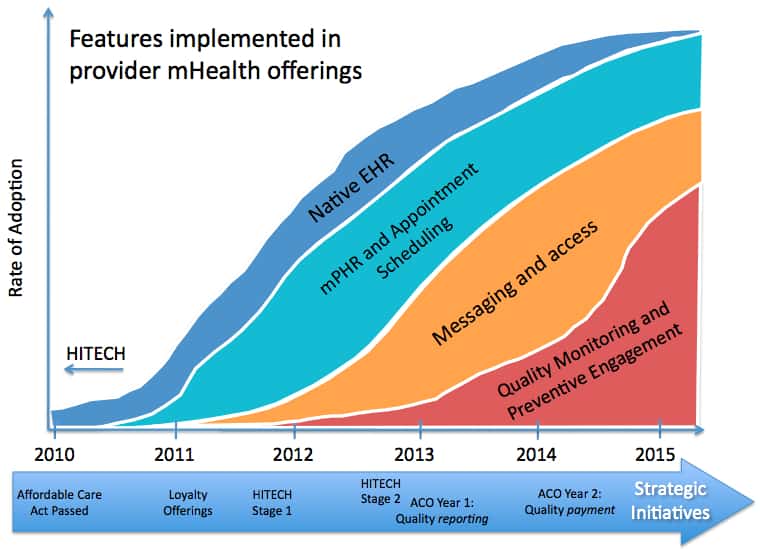The market is abuzz about all things mHealth. Press coverage on provider-patient mHealth solutions is ramping up with a recent example being the point–counterpoint piece in Forbes following the press waterfall about Happtique’s app-prescribing platform. We even wrote a piece recently about a personal experience using the iTriage app to self-diagnose E. Coli poisoning.
Here at Chilmark Research we have been following the adoption of mHealth solutions for some time and in addition to several private contracted studies for clients, published the report, mHealth in the Enterprise in late 2010.
We are now releasing our newest report, mHealth Adoption for Patient Engagement, Status, Trends and Forecast. This report takes a close look at adoption trends for mHealth apps that will facilitate provider-patient engagement. Our research uncovered a market with an enormous future ahead, (market will exceed $1.1B by 2017) but significant hurdles continue to stand in its way, at least for the near-term.
The report is both heartening and saddening. Heartening for the market will accelerate quickly in about three years time, a fairly short window for the healthcare sector. Saddened, because it means a lot of the current hype will overinflate expectations of impatient technology investors foraying into this unfamiliar space, greatly increasing the potential for high rates of failure as these investors pull the plug on their young prospects.
For the report, we started with the definition of mHealth from the WHO report mHealth, New Horizons for Health Through Mobile Technologies, published in 2011:
“…mHealth or mobile health is medical and public health practice supported by mobile devices, such as mobile phones, patient monitoring devices, personal digital assistants and other wireless devices.
We then narrowed the scope to those offerings that went beyond mere monitoring and are truly engaging care providers in more continuous, patient-centered care. What we found should surprise no one that follows this market: there is almost no current market demand for such solutions, and offerings today remain in perpetual pilot stage.
The market won’t really be one to speak of until 2014 comes around. This is when CMS begins basing quality payments on a competitive scale. The advantage for these payments will go to provider groups that have already starting internal testing of first line innovations such as two-way patient messaging services.
The current mobile priority for progressive healthcare organizations (HCOs) is simple transactional systems that allow a patient to view their records via a mobile optimized PHR portal, and perform simple transactions such as appointment scheduling and prescription refill requests. These initiatives are largely being driven by the marketing department of HCOs to increase member/patient loyalty.
Adoption of these services is still incentivized by current payment models, where fee-for-service reigns supreme. Scheduling tools have repeatedly been shown to decrease patient no-shows and are hugely popular among users. Increasing the opportunity to provide billable services in the short term will equate to greater access to care in the long term as patients have the opportunity to adjust appointments according to their schedule, reducing issues around last minute cancellations, which happen with approximately half of all primary care visits.
The true revolution is in its earliest stages as more innovative organizations start to adopt patient-physician messaging tools. Over the past few years, a number of doctors were already starting to do this to improve their connection with patients, but standard email is often not secure enough to meet the requirements of HIPAA compliance. This has led to a number of companies developing solutions specifically for the sake of enabling more secure communication, some of which are just starting to be worked into the mPHRs previously discussed.
These ad hoc messaging systems are the first generation of what will later become true patient engagement solutions that focus on specific chronic diseases driven in part with patient-derived data. This will result in fundamentally different models of care provision, as patient-generated data factors into proactive, near real-time decision-making.
Over the ensuing years we predict convergence of disease specific care provisioning mHealth apps with an mPHR, secure messaging and various transactional tools. Today, no HIT vendor, whether from the mHealth, PHR, EHR or other has publically articulated such a solution suite though many look to be heading in that direction. The recent announcement by Aetna of its win at Banner Healthcare may be a very early indicator of what is to come.





I’m not much into reading, but somehow I got to read many articles in your webpage. Its fantastic how interesting it is for me to visit you very often.
HIPAA compliant Text message services for EMR Health Services
Patients not taking their medication as prescribed is a recognised as problem to pharmaceutical and medical aid industries costing the millions in lost revenues. Most non-adherences relate to chronic conditions.
According NCPA study, 75% Americans don’t take their drugs as directed
I’d sure like to share our mHealth technology global penetration with your readers…